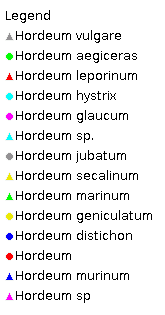Hordeum* Sp. Pl. 84 (1753).
Derivation:. Latin name for barley.
Syn: Critesion Raf.
Key references (keys and floras):. G.Bentham, Flora Australiensis 7: 669–670 (1878); C.A.Gardner, Flora of Western Australia 1 Gramineae 198–201 (1952); M.Lazarides, Flora of Central Australia 433 (1981); J.C.Tothill and J.B.Hacker, Grasses of Southern Qld 268–270 (1983); J.P.Jessop, Flora of South Australia 4: 1884–1886 (1986); B.K.Simon, Key to Australian Grasses 87 (Critesion) and 124 (1993); S.W.L.Jacobs and K.L.McClay, Flora of New South Wales 4: 598–600(1993); N.G.Walsh, Flora Victoria 2: 514–519 (Critesion treated as a separate genus) (1994); D.I.Morris, Student's Flora of Tasmania 4B: 296–300 (1994) (incl. Critesion); E.Edgar and H.E.Connor, Flora of New Zealand 5: 383–392 (2000) (Critesion) and 406–407; D.Sharp and B.K.Simon, AusGrass (2002); J.P.Jessop, Grasses of South Australia 267–273 (2006); S.W.L.Jacobs, R.D.B.Whalley & D.J.B.Wheeler, Grasses of New South Wales, 4th ed, 277–280 (2008); A.Wilson (ed.), Flora of Australia 44A: Poaceae 2: 110–116 (2009).
W.D.Clayton & S.A.Renvoize, Genera Graminum (1986), genus (237).
Naturalised. About 40 species, from north temperate regions & South America. 7 species in Australia, WA, SA, Qld, NSW, Vic, and Tas. Also New Zealand.
Habit. Annual or perennial, tufted (or the culms solitary). Leaf blades broad (rarely) or narrow. Ligule an unfringed membrane.
Inflorescence. Inflorescence a false spike, with spikelets on contracted axes (the spikelets in triads), a single raceme or spike, contracted. Spikelet-bearing axes falling entire.
Spikelets. Spikelets all partially embedded in rachis or not all embedded, laterally compressed to dorsally compressed, 1 flowered, with 1 fertile floret, in triplets (the triplets shed together), usually in pedicelled/sessile combinations (the central spikelet of each triplet sessile, the laterals pedicellate, with the broad side of the spikelets facing the axis); usually with naked rachilla extension (at least in the central spikelets of the triplets). Fertile spikelets falling with glumes (in the deciduous triplets) or not disarticulating (in cultivated forms).
Glumes. Glumes more or less equal, awned, similar (persistent, awn- or bristle-like above). Lower glume 1(–3) nerved. Upper glume 1(–3) nerved.
Florets. Fertile florets 1. Lemmas acuminate to an awn or awn point, similar in texture to glumes (leathery), not becoming indurated, entire at apex or incised, awned (nearly always) or mucronate (in some South American species), 5 nerved, glabrous. Awns 1, apical, non-geniculate, much shorter than body of lemma to much longer than body of lemma. Palea relatively long, entire or apically notched or deeply bifid, 2 nerved. Stamens 3. Grain small or medium sized or large, longitudinally grooved, compressed dorsiventrally, with hairs confined to a terminal tuft. Hilum long-linear. Embryo small.
Kranz Anatomy. C3.
2n = 14, 2, 4, and 6 ploid, commonly adventive.
Habitat. Mesophytic, xerophytic. Open weedy or sandy places, mostly in dry soils. Species of open habitats.
Classification. Pooideae; Triticeae.
Notes. A uniform genus of closely related taxa (Clayton and Renvoize, 1986). Critesion was formerly separated on the basis of a having a different genome, but cladistic work by Kellogg (1989) demonstrated it was not worth maintaining as a genus (B.K.Simon).
Types Species. H. vulgare L.
Biogeographic Element. Clifford & Simon 1981, Simon & Jacobs 1990: Naturalised.


